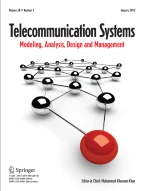Abstract
The most important challenge for the implementation of the Future Internet is to make the heterogeneity of access technologies transparent to the end user. Compared to the general case where the interworking networks are independent, the case of femtocells interworking with pre-existing wireless networks poses more challenges due to the sharing of the same backhaul capacity. Therefore, while a user is practically able to initiate the same service through multiple network interfaces, he is allocated capacity from the same capacity pool. However, while the femtocell inherits the QoS mechanisms of cellular networks and is able to provide a reliable CAC, this does not apply to the IP-based networks and that may drastically affect the performance of the femtocell. Hence, we propose an integrated Dynamic Service Admission Control (DSAC) framework for coexisting femtocell, wireless and wireline network environments. In particular, DSAC is able to provide QoS guarantees as a conventional capacity partitioning scheme while at the same time offers better performance in terms of acceptance probability and capacity utilization especially when short term variations of traffic load composition occur.
Similar content being viewed by others
Explore related subjects
Discover the latest articles, news and stories from top researchers in related subjects.References
Stuckmann, P., & Zimmermann, R. (2009). European research on future Internet design. IEEE Wireless Communications, 16(5), 14–22.
Sarakis, L., Kormentzas, G., & Guirao, F. M. (2009). Seamless service provision for multi heterogeneous access. IEEE Wireless Communications, 16(5), 32–40.
Statovci-Halimi, B., Franzl, G. (2011). QoS differentiation and Internet neutrality. Springer Telecommunication Systems. doi:10.1007/s11235-011-9517-1
Gustafsson, E., & Jonsson, A. (2003). Always best connected. IEEE Wireless Communications Magazine, 10(3), 49–55.
Song, W., Zhuang, W., & Cheng, Y. (2007). Load balancing for cellular/WLAN integrated networks. IEEE Network, 21(1), 27–33.
Zhang, J., & De La Roche, G. (2010). Femtocells: technologies and deployment. New York: Wiley. ISBN 978-0470742983.
Tipmongkolsilp, O., Zaghloul, S., & Jukan, A. (2011). The evolution of cellular backhaul technologies: current issues and future trends. IEEE Communications Surveys & Tutorials, 13(1), 97–113.
Chowdhurry, M. Z., et al. (2009). Dynamic SLA negotiation using bandwidth broker for femtocell networks. In Proceedings of 1st international conference on ubiquitous and future networks (ICUFN) (pp. 12–15).
Saunders, S., Carlaw, S., Giustina, A., Bhat, R. R., Rao, V. S., & Siegberg, R. (2009). Femtocells: opportunities and challenges for business and technology. New York: Wiley
De la Roche, G., Valcarce, A., Lopez-Perez, D., & Zhang, J. (2010). Access control mechanisms for femtocells. IEEE Communications Magazine, 48(1), 33–39.
Hasan, S. F., Siddique, N. H., & Chakraborty, S. (2009). Femtocell versus WiFi—a survey and comparison of architecture and performance. In Proceedings of 1st international conference on wireless communication, vehicular technology, information theory and aerospace & electronic systems technology (Wireless VITAE) (pp. 916–920).
Ping, X., Chandrasekhar, V., & Andrews, J. G. (2010). Open vs. closed access femtocells in the uplink. IEEE Transactions on Wireless Communications, 9(12), 3798–3809.
Navaie, K. (2011). On the interference management in wireless multi-user networks. Springer Telecommunication Systems, 46(2), 135–148.
Valcarce, A., Lopez Perez, D., De la Roche, G., & Zhang, J. (2009). Limited access to OFDMA femtocells. In 20th IEEE international symposium on personal, indoor and mobile radio communications (PIMRC).
Fan, Z., & Sun, Y. (2010). Access and handover management for femtocell systems. In IEEE 71st vehicular technology conference (VTC 2010-spring).
Ko, C. H., & Wei, H. Y. (2011). On-demand resource sharing mechanism design in two-tier OFDMA femtocell networks. IEEE Transactions on Vehicular Technology, 60(3), 1059–1071.
Chandrasekhar, V., Andrews, J. G., & Gatherer, A. (2008). Femtocell networks: a survey. IEEE Communications Magazine, 46(9), 59–67.
Knisely, D., Yoshizawa, T., & Favichia, F. (2009). Standardization of femtocells in 3GPP. IEEE Communications Magazine, 47(9), 68–75.
3GPP TS 22.220 V.10.3.0, Service Requirements for Home NodeBs (UMTS) and eNodeBs (LTE), Release 10 (2010).
Niyato, D., & Hossain, E. (2005). Call admission control for QoS provisioning in 4G wireless networks: issues and approaches. IEEE Network Magazine, 19(5), 5–11.
Iftikhar, M., Landfeldt, B., & Caglar, M. (2009). Towards the formation of comprehensive SLAs between heterogeneous wireless DiffServ domains. Springer Telecommunication Systems, 42(3–4), 179–199.
Kulkarni, P., Chin, W. H., & Farnham, T. (2010). Radio resource management considerations for LTE femtocells. ACM SIGCOMM Computer Communication Review (CCR), 40(1), 26–30.
Kang, S. B., et al. (2008). Soft QoS-based CAC scheme for WCDMA femtocell networks. In Proceedings of 10th international conference on advanced communication technology (ICACT) (pp. 409–412).
Makris, P., & Skianis, C. (2008). Multi-scenario based call admission control for coexisting heterogeneous wireless technologies. In IEEE global telecommunications conference (GLOBECOM), New Orleans, USA.
3GPP TS 25.467 V.9.3.0, UTRAN Architecture for 3G Home Node B (HNB), Release 9 (2010).
Blake, S., Black, D., Carlson, M., Davies, E., Wang, Z., & Weiss, W. (1998). An architecture for differentiated services. RFC 2475.
Wang, X. G., Min, G., Mellor, J. E., Al-Begain, K., & Guan, L. (2005). An adaptive QoS framework for integrated cellular and WLAN network. Elsevier Computer Networks Journal, 47(2), 167–183.
3GPP TS 23.107 V.9.1.0, Technical Specification Group Services and Systems Aspects; End-to-end Quality of Service (QoS) concept and architecture, Release 9 (2010).
Author information
Authors and Affiliations
Corresponding author
Rights and permissions
About this article
Cite this article
Skoutas, D.N., Makris, P. & Skianis, C. Optimized admission control scheme for coexisting femtocell, wireless and wireline networks. Telecommun Syst 53, 357–371 (2013). https://doi.org/10.1007/s11235-013-9703-4
Published:
Issue Date:
DOI: https://doi.org/10.1007/s11235-013-9703-4
